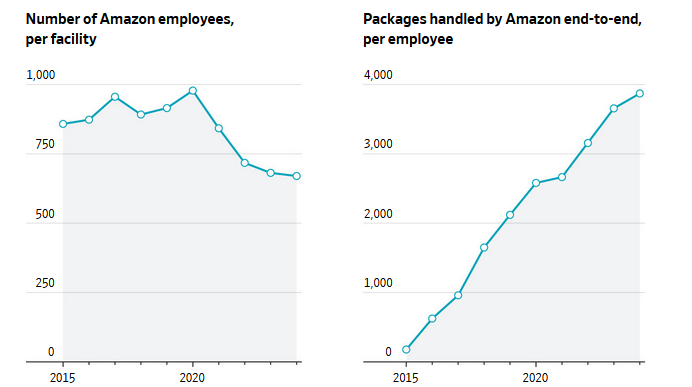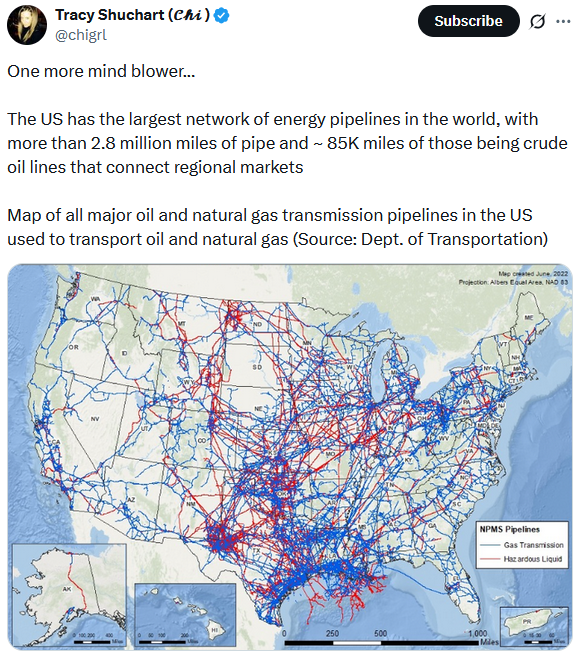Street Calls of the Week
The age of robotics is no longer a futuristic concept. Per a Wall Street Journal article entitled, Amazon (NASDAQ:AMZN) is on the cusp of using more robots than humans in its warehouses, Amazon now has over one million robots in its warehouses doing the work that humans once handled. More impressively, the million robots are nearing the 1.5 million mark in size, which is equivalent to the entire workforce.
While the robots perform basic stocking and selecting tasks from their warehouse facilities, they also utilize more advanced robots, such as Vulcan, which has a sense of touch. Furthermore, the robots are connected to the order fulfillment process, allowing them to work in tandem with humans.
While robots will certainly replace some human jobs, they are also leading to the advancement of others. Per the article:
Now some 75% of Amazon’s global deliveries are assisted in some way by robotics, the company said. The growing automation has helped Amazon improve productivity, while easing pressure on the company to solve problems such as heavy staff turnover at its fulfillment centers.
For some Amazon workers, the increasing automation has meant replacing menial, repetitive work lifting, pulling and sorting with more skilled assignments managing the machines.
“I thought I was going to be doing heavy lifting, I thought I was going to be walking like crazy,” said Neisha Cruz, who spent five years picking items at an Amazon warehouse in Windsor, Conn., before she was trained to oversee robotic systems.
The primary benefit of Amazon robots is increased productivity. According to the WSJ graphs below, the number of packages handled per employee has increased, while the number of employees per facility has decreased.
What To Watch Today
Earnings
- No notable earnings releases today
Economy
Market Trading Update
Yesterday, we discussed the technical backdrop to the continued market rally, setting another all-time high. The bulls remain in control of the market currently, but speculative action indeed suggests risks are present. With that, I thought this bull/bear assessment of the market from JP Morgan was worth sharing, as it aligns with our views.
BULL CASE
- (i) Bullish Macro (BCBA:BMAm) Data – the labor market is the most important macro variable and NFP above 100k should be enough to keep the SPX on track to make new ATHs;
- (ii) Inflation Fails to Spike – dovetailing with labor markets is the inflation picture and the July 15 CPI print looms large and a failure to see a material increase may mean that any future spikes are discounted given the likelihood of a new series of trade deals which may lower effective tariff rates;
- (iii) A Wave of Trade Deals – the expectation is for a series of trade deals that may look like the US/UK deal which has a 10% baseline tariff and then additional tariffs that kick in above a quota level of imports and anything that is less onerous would be an upside surprise for all countries, ex-China. With China, an agree that loosens chip restrictions or lowers absolute levels is a positive
- (iv) Budget / Tax Bill Does Not Spike Bond Yields – Given the US fiscal situation and estimates ~$3.5T increase in the deficit, there is a risk that the backend of the yield curve rises materially especially with the BOJ potentially hiking reducing demand for USTs.
- (v) Earnings Surprise – we have seen estimates cut more than usual this earnings season, so the low bar is set. If Financials and MegaCap Tech beat estimates then that is likely to create momentum into the Aug 28 NVDA report.
BEAR CASE
- (i) Bearish Macro Data – Powell flagged the risk of seeing trade war impacts in the June – Aug data and if that is not reflected in the next batch of macro data we may see Bears start to abandon their recessionary views similar to 2023 and 2024, years where the majority of the Street forecasted a recession
- (ii) Bond Yield Spike – Equities can digest most levels of rates but spikes to bond vol and/or new highs in yields (10-Year current cycle high is 5%) take time to digest and a yield spike in relation to hotter inflation data is worse for risk assets than a rise due to increasing growth;
- (iii) Re-escalation of the Trade War – Whether it is China and rare earths or Canada and a digital tax the market still has risks for re-escalation with the most bearish outcome being a reversion to ‘Liberation Day’ levels as the outcome would be a return to the Stagflationary Narrative;
- (iv) Budget / Tax Bill is ‘Rejected’ by Bond Market – while the GOP is using atypical accounting to pitch the bill’s cost ~$450bn, traditional methods place the cost ~$4T and the CBO’s scoring shows a $3.3T cost but with the debt ceiling raised by $5T, the bond market may not treat the bill as a market-friendly.
- (v) Earnings Puke – bull markets are usually ended by a recession or recession-like indictors and in this case we likely need to see negative EPS growth to support the bear case though muddled guidance can have the same impact. Realistically, Bears need MegaCap Tech to see a significant number of misses.
US MKT INTEL VIEW
We remain Tactically Bullish. We think the macro data will deliver enough optimism to keep the SPX poised to create a new series of ATHs. Earnings have a low enough bar, and we think that between Financials and Tech that is enough to carry the market higher throughout the earnings season, with the NVDA print just before Labor Day enough to excite investors into Q4. The last pieces to the puzzle are taxes and trade.
- On taxes, we think the bill passes but do not anticipate an immediate, negative reaction from the bond market. Overtime, the bond market may reject US fiscal actions, but think this can be reduced if we see a stronger GDP growth profile which we anticipate once there is clarity on the trade war.
- On trade, we do think we see a series of trade agreements hit the tape soon with the impact a reduction in the effective tariff rate, while we may see some turbulence with trade especially if Trump adds Pharma/Semis sectoral tariffs, for now the market will look through those potential events.
Further, we think the July 9 date gets rolled to avoid any market volatility; the Administration is unlikely to let ‘Liberation Day’ levels return given the magnitude of downside in risk assets as ‘Liberation Day’ pushed SPX -10.8% in two days.
RISKS
- (i) NFP downside surprise;
- (ii) Failure to secure trade deals including a re-escalation with Canada, China, and the EU on digital taxes, rare earths, and retaliation for a baseline tariff;
- (iii) Israel/Iran situation devolves pulling the US into the war which could be catalyzed by an Iranian attack on Saudi oil production and/or US military bases.
Our assessment
A substantial risk of an NFP downside surprise this week is likely, which will likely pull Fed rate cut estimates forward. While that may provide a short-term boost to markets, the risk is that earnings estimates are revised lower, ultimately leading to a realignment of valuations. Continue to manage risk, but remain invested currently.
Powell Repeats Himself
Jerome Powell spoke at an ECB forum in Portugal yesterday. He essentially reiterated what he had testified to Congress the previous week and many of the same points he had made at the post-FOMC press conference. Here are five takeaways:
- U.S. Economy: Powell described the U.S. economy as “healthy overall.” He didn’t mention recent weaker employment readings.
- Inflation Expectations: He noted that inflation is behaving as expected, provided tariff impacts are ignored. We are unsure what he means by ignoring tariff impacts, as inflation has been very tame with the tariff impacts thus far.
- No Rush to Cut Rates: Powell said the Federal Reserve is not in a hurry to cut interest rates, maintaining a wait-and-see stance. Relative economic strength and concerns that inflation will rise due to tariffs keep Powell from endorsing rate cuts.
- Current Policy Stance: Despite what Fed Presidents Waller and Bowman think, the Fed is “on hold” for now, implying no immediate changes to monetary policy.
- Inflation Risks: Powell highlighted that higher inflation risks remain, due to potential tariff effects, which the Fed is monitoring closely.
Tweet of the Day

